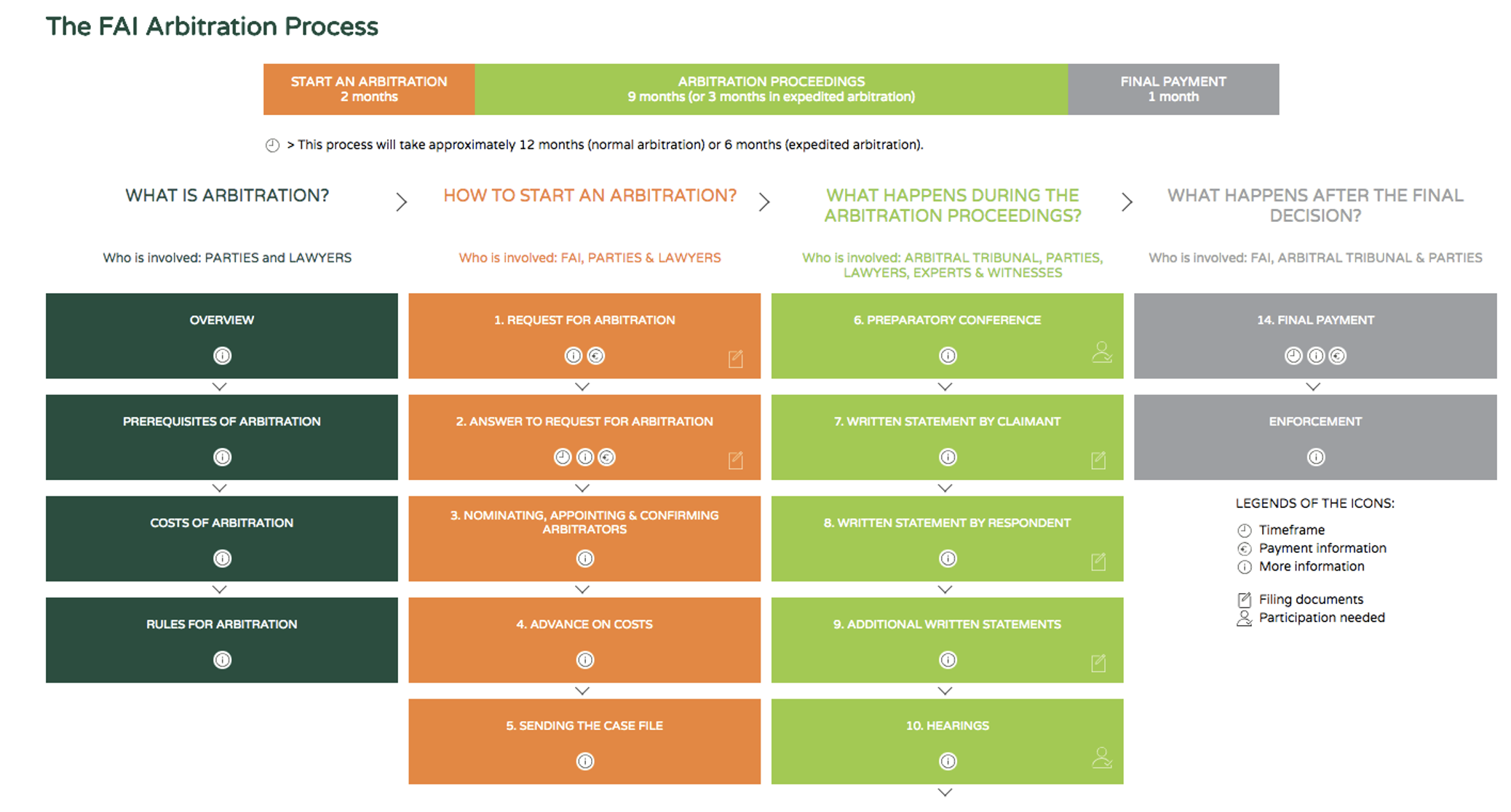It was around 367 BCE when Plato wrote Νόμοι (The Laws), marking the first proper consideration of arbitration as a method for resolving private disputes. This work highlighted arbitration’s cost-effectiveness, the autonomy it provides through arbitrator selection, and the expertise and impartiality of arbitrators. Fast forward to today, arbitration is increasingly embraced by the international community as a primary method for resolving complex transnational disputes, valued for similar reasons.
Nonetheless, recent criticisms of international arbitration include its high costs, inefficiency, and the challenges posed by linguistic and cultural differences, as well as a perceived lack of a client-driven approach and innovation. Legal Design could represent a fresh and innovative approach poised to solve these challenges. By applying design thinking to the legal sphere, Legal Design transforms cumbersome legal processes into streamlined, user-centric experiences, offering a promising pathway to enhance arbitration proceedings.
Issues Facing International Arbitration
In international arbitration, language barriers pose significant challenges, given that English, serving as the common medium akin to Latin in historical contexts, might not be fluently spoken by all parties involved. This scenario leads to potential misunderstandings and procedural delays, affecting the outcome of arbitration proceedings. The case of Kılıç v. Turkmenistan exemplifies these complications when discrepancies arose from multiple language versions of the BIT between Turkey and Turkmenistan. Despite the treaty’s official languages being English and Russian, issues were compounded by unofficial Turkish translations and the lack of an authentic Turkmen version. The English text was also criticised for grammatical errors and ambiguity, affecting key treaty interpretations. These language issues, highlighted in a separate opinion by William W. Park, accentuated the critical need for effective language management in arbitration settings.
Furthermore, there is a push towards a more client-centred approach in arbitration, prioritising the specific needs of the parties and allowing them more control over the dispute resolution process. This aims to enhance satisfaction and perceived fairness by engaging parties more directly.
Additionally, the 2015 Queen Mary/White & Case International Arbitration Survey pointed out concerns regarding arbitration’s “cost” and “lack of speed”. These criticisms emphasise the urgency to develop and implement strategies that streamline processes and reduce expenses, thereby making arbitration a more appealing and efficient method for resolving international disputes.
Legal Design as a Promising Solution
While arbitration retains some ancient characteristics, there is a pressing need for its evolution to better meet the modern demands of clients, businesses, and markets. In the quest for innovation within the arbitration landscape, Legal Design offers a promising solution. Legal Design is a nascent movement characterised by a highly interdisciplinary approach, merging law, design, technology, and behavioural science to make legal systems more human-centred, usable, and satisfying. Legal Design re-centres legal systems around humanity, emphasising that laws were created to serve people and should therefore be more accessible and effective for them.
Legal Design employs various design tools and methods to enhance the accessibility and user-friendliness of legal systems, including the use of visual representations and plain language to improve the delivery of legal information. Visual aids help simplify complex concepts, enhance retention, and make legal documents less daunting. Meanwhile, plain language involves using straightforward, jargon-free communication that eases comprehension and navigation through logical information structuring. These innovations not only help legal professionals save time by simplifying the understanding of complex documents, but also lead to more efficient legal service delivery.
The Visual Nature of Human Beings
As anticipated, Legal Design emphasises the central role of human beings in legal systems. This focus mirrors a consistent element in the evolution of arbitration and all ADR mechanisms: the predominant role of human beings. Humans have a distinct visual nature, responding and processing visual data more effectively than textual data. Evolutionarily, the ability to recall visual aspects of the environment is crucial for survival, explaining why visual memory is highly developed. Scientific findings reveal that the human brain processes images almost 60,000 times faster than text, with over 90% of the information processed by the brain being visual. People can remember over 2000 pictures with at least 90% accuracy in recognition tests over several days, far surpassing the ability to recall words. An MIT study showed the brain could process images in as little as 13 milliseconds, whereas understanding a complete sentence takes much longer. Therefore, incorporating visual elements into legal documents can greatly improve comprehension and communication whilst reducing the cognitive burden of deciphering complex texts.
Given this, how can it be that arbitration proceedings often overlook the intrinsic information-seeking characteristics of the human brain?
The importance of employing visual elements becomes even more evident when considering the diverse cultures and languages involved in international arbitration. In these contexts, visual representations, when carefully tailored to account for cultural differences, can overcome language and cultural barriers, providing a common language that all parties can understand and rely on to efficiently resolve disputes.
Legal Design can also address language barriers by minimising dense text and using visuals to clarify complex legal concepts, crucially important given the OECD’s findings that a significant portion of the global adult population has low literacy levels. This approach not only aids those with limited language skills but also supports vulnerable groups, like the elderly or children, enhancing understanding and reducing the risk of costly errors.
Moreover, visuals can diminish the perception of discomfort often associated with legal processes, creating an open and collaborative environment. This is essential in arbitration and other ADR processes like negotiation and mediation, where clear communication and mutual understanding can lead to more effective engagement and consensus-building. Ultimately, the strategic use of visual elements not only expedites the resolution process but also enhances the likelihood of achieving lasting, satisfactory outcomes for all parties involved, demonstrating that effective legal communication in the modern era requires a holistic approach that integrates the power of visualisation.
Examples of Legal Design Applied to International Arbitration
In light of the growing recognition of the value of visualisation in legal contexts, practical examples of Legal Design’s impact are increasingly evident in international arbitration, reflecting a nascent trend. Visual aids such as slides are occasionally employed in arbitration hearings to clarify points and enhance presentations, although their adoption is still evolving and not yet common practice. These methods have proven effective in streamlining discussions and in helping arbitrators and parties alike to quickly grasp complex legal and factual issues.
A project undertaken by the Universidad Católica San Pablo in Peru, in collaboration with the legal design consultancy WOW Legal Experience (“WOW”), exemplified the practical application of Legal Design in enhancing arbitration. The project focused on improving the presentation materials of the university’s arbitration moot team and developing better documentation practices for international arbitration. The aim was to refine these documents to streamline the arbitration process and show how Legal Design can improve the efficiency and clarity of arbitration procedures. This initiative holds implications not only for the moot team’s performance but also suggests benefits for broader adoption by national and international arbitration centres, encouraging them to integrate Legal Design into their standard practices and documentation. The final results included redesigning different documents:
1. Arbitration Case: WOW presented the facts in a more visual, and understandable manner.

2. Arbitration Award: WOW worked on prototyping an arbitration award to articulate the reasoning and legal grounds of the arbitral tribunal more clearly.

3. Arbitration Rules: WOW focused on making the rules guiding specific arbitration processes clearer for the parties involved by incorporating visual elements.

The key takeaway from this example is that applying Legal Design principles to arbitration can significantly improve the process: by using visual aids and plain language, arbitration documents can be redesigned to enhance understanding for all parties involved. Legal Design techniques can also simplify the often-complex arbitration rules, making them more accessible and straightforward. This can improve the clarity and usability of arbitration materials and increase the overall efficiency of the arbitration process.
In this regard, in 2018 the Finland Arbitration Institute (FAI) partnered with Dottir, a law firm with a Legal Design consultancy spin off, and Hellon, a design agency, to innovatively redesign how its arbitration services are delivered. The FAI administers arbitrations and mediations pursuant to its rules. These rules provide a detailed framework for dispute resolution. However, despite their comprehensive nature, inquiries from FAI users or potential users showed that the FAI Rules were not always clear to those less familiar with arbitration, leading to a demand for more accessible information.
To bridge this gap, the FAI turned to Legal Design, recognising its potential to enhance the accessibility of and engagement with arbitration rules and procedures for end users. Collaborating with Dottir and Hellon, the FAI embarked on a legal design project which resulted in the creation of the FAI Arbitration Process flowchart. Launched at the Helsinki International Arbitration Day on 24 May 2018, the flowchart was designed to make the arbitration process more understandable and user-friendly. This tool has since played a role in the industry in helping to improve understanding and practical engagement with the arbitration process.

During workshops, participants, predominantly lawyers, expressed a strong preference for the visual components of the flowchart, aligning with broader preferences for visual learning. Based on these positive responses, Dottir has been advocating for the legal sector to embrace Legal Design to innovate and enhance services. By merging legal expertise with design thinking and a focus on human needs, Legal Design has the potential to significantly improve the user experience and truly transform how legal services are delivered.
Conclusion
International arbitration, challenged by issues like language barriers, inefficiency, and client dissatisfaction, can benefit greatly from Legal Design. Moreover, integrating Legal Design can streamline arbitral decision-making processes, allowing for more efficient resolutions.
The relationship between arbitration and Legal Design is crucial and mutually beneficial. It involves more than choosing between textual and visual elements; instead, it focuses on what best serves the end users, whether they are clients or arbitrators. While visuals alone are not usually sufficient, they significantly enhance comprehension when used to complement textual information. The integration of Legal Design into ADR tools signifies a commitment to continuous innovation tailored to user needs. As global business dynamics evolve, embedding Legal Design principles into arbitration becomes critical for tackling fundamental issues not only to refine how arbitration is conducted, but also to redefine the expectations and outcomes of ADR.
________________________
To make sure you do not miss out on regular updates from the Kluwer Arbitration Blog, please subscribe here. To submit a proposal for a blog post, please consult our Editorial Guidelines.


